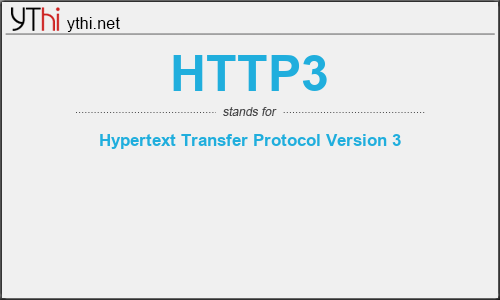What does HTTP3 mean? What is the full form of HTTP3?
1, The full form of HTTP3 is Hypertext Transfer Protocol Version 3
the QUIC transport protocol has several features that are desirable in a transport for HTTP, such as stream multiplexing, per-stream flow control, and low-latency connection establishment. This document describes a mapping of HTTP semantics over QUIC. This document also identifies HTTP/2 features that are subsumed by QUIC, and describes how HTTP/2 extensions can be ported to HTTP/3.
HTTP/3 provides a transport for HTTP semantics using the QUIC transport protocol and an internal framing layer similar to HTTP/2
Once a client knows that an HTTP/3 server exists at a certain endpoint, it opens a QUIC connection. QUIC provides protocol negotiation, stream-based multiplexing, and flow control. Discovery of an HTTP/3 endpoint is described in Section 3.1
Within each stream, the basic unit of HTTP/3 communication is a frame (Section 7.2). Each frame type serves a different purpose. For example, HEADERS and DATA frames form the basis of HTTP requests and responses (Section 4.1). Frames that apply to the entire connection are conveyed on a dedicated control stream
Multiplexing of requests is performed using the QUIC stream abstraction, described in Section 2 of [QUIC-TRANSPORT]. Each request-response pair consumes a single QUIC stream. Streams are independent of each other, so one stream that is blocked or suffers packet loss does not prevent progress on other streams
Server push is an interaction mode introduced in HTTP/2 ([HTTP2]) that permits a server to push a request-response exchange to a client in anticipation of the client making the indicated request. This trades off network usage against a potential latency gain. Several HTTP/3 frames are used to manage server push, such as PUSH_PROMISE, MAX_PUSH_ID, and CANCEL_PUSH
As in HTTP/2, request and response fields are compressed for transmission. Because HPACK ([HPACK]) relies on in-order transmission of compressed field sections (a guarantee not provided by QUIC), HTTP/3 replaces HPACK with QPACK ([QPACK]). QPACK uses separate unidirectional streams to modify and track field table state, while encoded field sections refer to the state of the table without modifying it.
see also What does HTTP2 mean? What is the full form of HTTP2?
see also What does HTTP1 mean? What is the full form of HTTP1?
see also What does HTTP3 mean? What is the full form of HTTP3?
HTTP3
means
Hypertext Transfer Protocol Version 3![]()
Translate Hypertext Transfer Protocol Version 3 to other language.


Leave a Reply
You must be logged in to post a comment.